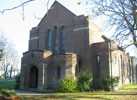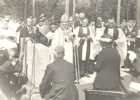 Sneinton Sneinton
St Cyprian
History
At the beginning of the 20th century, the land upon which St Cyprian’s
Church was eventually built was part of a sparsely populated green field area
on the very edge of the City of Nottingham’s 1877 boundary. Only a few
farm houses and cottages were scattered amongst the newer houses built to accommodate
the city’s population drift to the green suburbs. The site at the top
of a hill overlooked the east and south of the city and beyond into the Trent
valley. This area of fruit orchards, allotments and pastures contrasted sharply
with the patch of housing at the bottom of the hill, consisting of streets
and courts of densely packed slum dwellings known as Sneinton Elements. In
this area housing and sanitary conditions were very basic. It was common for
several houses to share a block of outside toilets and many houses were still
lit by gas. (Contrast the new developments around the proposed church site,
with their bathrooms, private gardens and inside toilets.) The whole area at
the time was served by St Matthias’
Church nearer the city and St Paul’s (Carlton) on the county
side. Both these churches were built in the latter part of the 19th century.
Nearby was the tiny corrugated iron Mission Church dedicated to St Clement.
It must have become apparent to the Bishop of Southwell
that the rapidly expanding population warranted more facilities when he invited
the Rev Vincent Travers Macy to take charge of the designated church district
and develop the site. In 1913 the first church building and the vicarage were
completed to a design by the Nottingham firm of architects Messrs John Howitt
and Sons. The small church, to accommodate a congregation of two hundred, was
built of red Nottingham brick, possible produced at the brick kilns then only
a few hundred yards away.
The intention was to build a larger Parish Church as the congregation increased.
However, the First World War delayed the implementation of the longer term
plan. Sadly, Fr Macy’s war duties affected his health, resulting in his
departure in 1920. It was not until 1927, when St Cyprian’s was
designated as a ‘Peel parish’ with the Rev Mr Killer as its vicar,
that increasing use of the 1913 building, now with a Sunday school roll exceeding
350, led to renewed development planning. Recognising the need, the Diocesan
Authority donated £6500 from the sale of the recently demolished St Paul’s
Church in George Street in the city centre. The redundancy of St Paul’s
reflected the drift of the population from the city centre to the suburbs.
The same firm of local architects were appointed, Messrs John Howitt and Sons,
Mr Claude Howitt taking personal responsibility for the design. Initially ‘a
rather ambitious scheme’ for a building with a capacity of 600 in the
Gothic style, was produced. Potential costs subsequently caused this to be
abandoned. The second design was very different, being
regarded as ‘modernistic’. Seating was reduced to 400 in a spacious
open-plan building, with a broad nave, side ambulatories and chairs rather
than pews. It was estimated that the new design would cost about £8500.  This
was more agreeable and after evensong on Sunday, 13th May 1934 the Rev Mr Killer
cut the first turf for the building work to start the next day. Work on the
site must have been well planned and executed, by Thursday 10th July the foundations
and brickwork to floor level, plus the sub-floor had been completed, allowing
Fr and Mrs Macy to return to the church to lay the foundation stone in the
presence of the Bishop of Southwell. Mr Killer wrote a special hymn for the
occasion, and made an appeal to the congregation for the £1000 needed
to complete. The new church was finally consecrated on 15th May 1935 by the
Bishop of Southwell This
was more agreeable and after evensong on Sunday, 13th May 1934 the Rev Mr Killer
cut the first turf for the building work to start the next day. Work on the
site must have been well planned and executed, by Thursday 10th July the foundations
and brickwork to floor level, plus the sub-floor had been completed, allowing
Fr and Mrs Macy to return to the church to lay the foundation stone in the
presence of the Bishop of Southwell. Mr Killer wrote a special hymn for the
occasion, and made an appeal to the congregation for the £1000 needed
to complete. The new church was finally consecrated on 15th May 1935 by the
Bishop of Southwell
Until 1917 baptisms at St Cyprian’s were recorded in the registers of
St Paul’s Carlton. Fr Macy opened the St Cyprian’s Baptism
Register on 15th January 1919 with the ceremony for Albert Raymond Cutts. The
last baptism in the old building was on 23rd April 1935, for Mavis Richards.
The church was not licensed for marriages until November 1930. All previous
marriages were recorded in the registers of St Paul’s or St
Matthias’. Excepting those in current use, all St Cyprian’s
registers are lodged in the Nottinghamshire County Archives
In 1913 when the church district was established, only a handful of other
places of worship were located within a few minutes’ walk of the site.
Today there are 18. Some of these host religious communities unheard of in
1913 demonstrating the changing nature of beliefs and the community during
the 20th Century
Over the years the surrounding green fields have disappeared under a network
of roads and housing developments. The parish is now partly within the City
of Nottingham, and partly in the Borough of Gedling. The brickyard, the probable
source of the red bricks for the original building, now hosts a small estate
of dwellings, but the area still retains some of its leafy suburb appearance,
with mature trees surrounding the still modern looking St Cyprian’s.
The Original Church Building
 The
original church building on the site was completed in 1913. It is very much
a building typical of the area and the period of its design. The main construction
material used is red Nottingham brick of standard imperial size. It may well
have been produced from clay cut, shaped and fired at the brickyard only a
few hundred yards down the hill. Ancaster stone has been used to frame the
door ways and window openings, and decoratively as a plinth course set some
two feet above ground level. The gable walls rise above the roof line, and
are capped with stone now considerable darkened by exposure to the elements.
A small stone cross is set at the apex. In the very centre of the roof ridge
an ornate square wooden-louvred turret, surmounted with a weathered copper-covered
roof, adds a dimension of age and purpose. This may well have been the original
bell turret. The
original church building on the site was completed in 1913. It is very much
a building typical of the area and the period of its design. The main construction
material used is red Nottingham brick of standard imperial size. It may well
have been produced from clay cut, shaped and fired at the brickyard only a
few hundred yards down the hill. Ancaster stone has been used to frame the
door ways and window openings, and decoratively as a plinth course set some
two feet above ground level. The gable walls rise above the roof line, and
are capped with stone now considerable darkened by exposure to the elements.
A small stone cross is set at the apex. In the very centre of the roof ridge
an ornate square wooden-louvred turret, surmounted with a weathered copper-covered
roof, adds a dimension of age and purpose. This may well have been the original
bell turret.
The main entrance is within an extended porch on the south-facing gable-end
wall, which leads into the main body of the building now used as the church
hall. It has a high open ceiling with heavy exposed roof timbers currently
darkly stained.
A further entrance is located on the side of the building near the rear, giving
access to small rooms used as service areas - possibly the original vestries.
The building appears to be in fair condition and is well used by local groups.
A small stage has been installed, but there is no internal evidence of the
building’s original use.
| 




